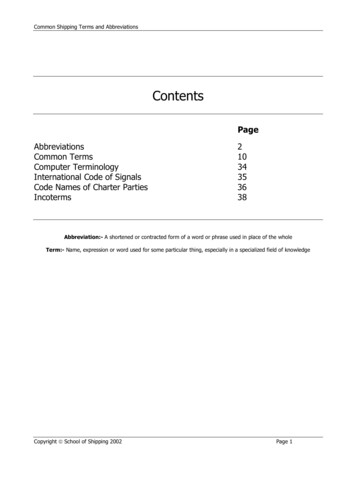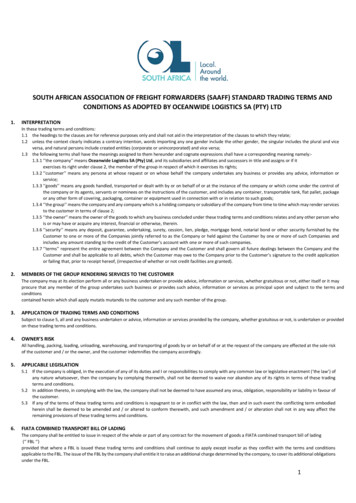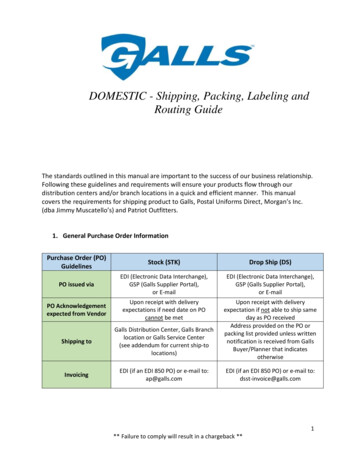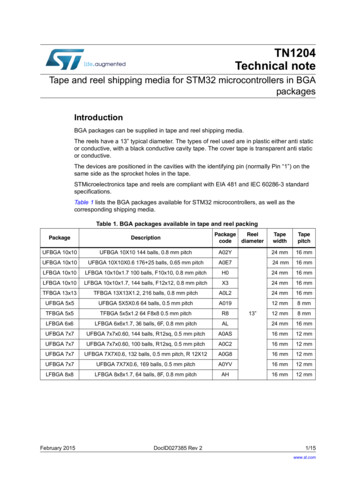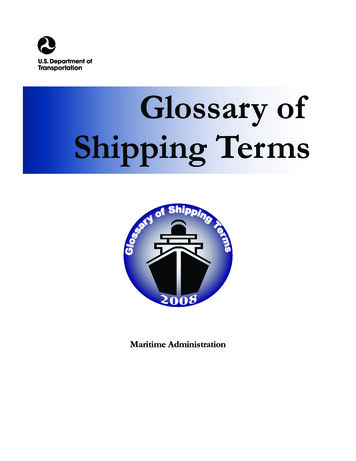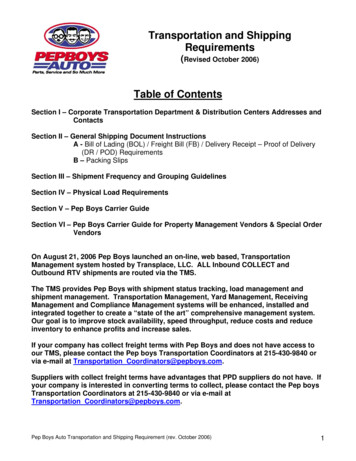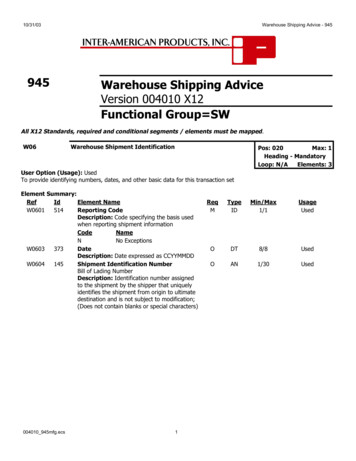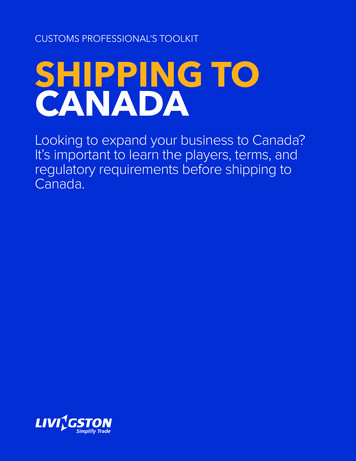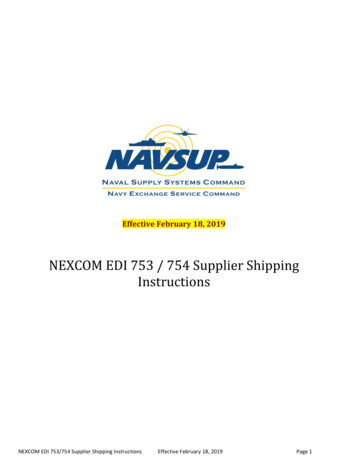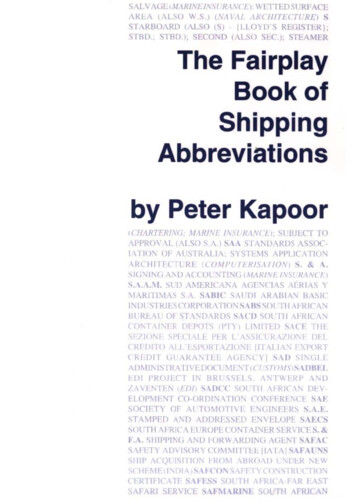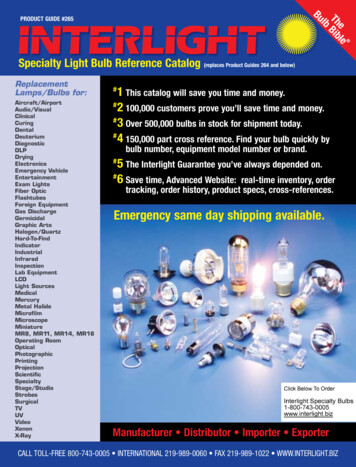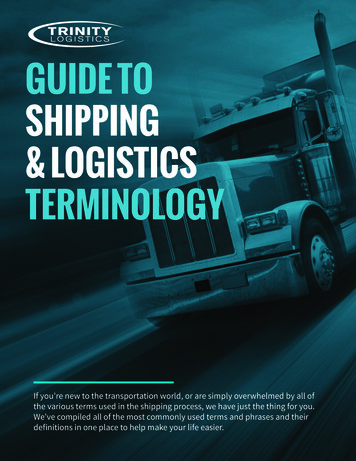
Transcription
GUIDE TO SHIPPING & LOGISTICS TERMINOLOGYGUIDE TOSHIPPING& LOGISTICSTERMINOLOGYIf you’re new to the transportation world, or are simply overwhelmed by all ofthe various terms used in the shipping process, we have just the thing for you.We’ve compiled all of the most commonly used terms and phrases and theirdefinitions in one place to help make your life easier.
GUIDE TO SHIPPING & LOGISTICS TERMINOLOGYTABLE OF ZI5R7
GUIDE TO SHIPPING & LOGISTICS TERMINOLOGYAAccessorial: An extra fee charged by carriers for additional services rendered,which can include detention and fuel surcharges.Asset-based: A transportation company that owns its own equipment, usuallytrucks or containers.Bill of Lading (BOL): A transportation document that acts as a contract betweena shipper and receiver and includes details specific to the shipment.BBlanket rates: Lower, contracted rates you can obtain from LTL carriers if youhave enough shipping volume.Blocking and bracing: A method of securing cargo to prevent shifting duringtransportation.Bulk cargo: A cargo commodity that is transported unpackaged in largequantities. For example, coal and gravel.Capacity: The availability of carriers and equipment to haul freight.Cargo: Goods or product being shipped.Carrier: A person or business that transports goods, usually usedinterchangeably with “trucking company.”Certificate of Insurance: A document noting that insurance has been secured tocover loss or damage to a shipment while in transit.CClaim: A charge made against a carrier by a shipper or consignee due to loss,damage, or delay to the shipment.Commodity: The type of goods you are shipping.Consignee: The receiver of a shipment.Container: A box or trailer used for shipping goods.Council of Supply Chain Management Professionals (CSCMP): A professionalassociation dedicated to the advancement of the logistics and supply chainindustries.
GUIDE TO SHIPPING & LOGISTICS TERMINOLOGYCCross docking: The process of unloading inbound freight and immediatelyloading it onto a different outbound method of transportation, often across thesame dock.Customs broker: A firm that represents importers and exporters in dealing withcustoms in international shipments and is responsible for gathering all necessarydocuments to do so legally.Deadhead: A truck traveling without freight in order to pick up its next load.Dead on Arrival (DOA): When a product is delivered in a non-functionalcondition.Declared value: The value of freight in a shipment as noted by the shipper on abill of lading.DDensity rates: LTL shipping rates that are based on the shipment’s density andsize, rather than on their freight class.Department of Transportation (DOT): A federal organization designed tomanage the country’s transportation system and functions.Detention: Additional shipping costs charged by a carrier if they must waitbeyond the specified loading and unloading times.Dispatch: A job function of the carrier to arrange drivers, tracing of drivers, andequipment for specified shipments.Door to door: A shipment arranged by a single transportation provider thattravels directly from the shipper to the consignee.Door to port: A shipment arranged by a single transportation provider thattravels directly from the shipper to a port.Drayage: The transport of ocean or rail containers to and from ports or rail yards.Drop trailer: A type of shipment when a carrier drops off their trailer at a facilityfor an extended period of time.EEnroute: When a shipment is in the middle of its transport.Expedited shipping: A form of transportation that involves shipments beingmoved at a faster rate than usual.
GUIDE TO SHIPPING & LOGISTICS TERMINOLOGYFederal Motor Carrier Safety Administration (FMCSA): A federal organizationwhose primary mission is to reduce crashes, injuries and fatalities involving largetrucks and buses.Freight All Kinds (FAK): Refers to a negotiated LTL rate based on the combinedfreight class of multiple commodities.FFlatbed: A type of trailer that has a long floor, but is not enclosed. This is oftenused to ship large products, like equipment or pipes, that wouldn’t ordinarily fitin the confines of a normal trailer.Freight: Goods being transported from one place to another.Freight class: A classification of LTL shipments based on the freight’s weight,length, height, density, ease of handling, and value.Freight forwarder: A company that specializes in the arranging and storage offoreign shipments.Freight quote: Estimated pricing from a carrier or 3PL for the arrangement andshipping of specific freight on a specific lane.GGoods: Another term for freight or product.Hazmat: A type of specialty shipment that involves the transport of hazardousmaterials.HHotshot: A specialty LTL shipment that has a single customer’s freight on boardwithout multiple stops.Heavy haul: A specialty shipment for goods heavier than normal truckload willallow for.IInsurance certificate: An official document issued to the consignee that outlinesthe insurance provided to cover potential loss or damage of freight while it’s intransit.Intermodal: A shipping mode that involves multiple modes of transportation.Most commonly, this refers to utilizing the rail in addition to trucks.International shipping: Transportation of goods into or out of foreign countries.
GUIDE TO SHIPPING & LOGISTICS TERMINOLOGYJJust in Time (JIT): A specialty transportation service that is based on thematerial flow of manufacturing companies. Products are delivered only whenthey are needed to cut down on required storage space.KLane: The commercial route between the origin and the destination of yourshipment. For example, “Miami to Chicago is a great lane for this carrier.”Layover: Extra charges from a carrier for the extra time (a day or more) spentwaiting to load or unload at a shipper or receiver.Less-Than-Truckload (LTL): A mode of transportation for freight that would notfill a full truckload trailer.LLiftgate: A mechanical platform on the back of a vehicle that can be raisedduring loading and unloading of heavy cargo. This is used when the shipper orconsignee do not have a loading dock on site to load or unload the freight.Logistics: The coordination of activities and transportation needed to bringgoods to market.LTL Terminal: Where LTL carriers load and unload freight that needs to switchtrucks on the way to its final destination.Lumper: Additional fee charged to the carrier when a shipper utilizes a thirdparty worker, called a lumper, to help load or unload trailer contents.Mileage: The distance a carrier travels for a shipment, which is a determiningfactor in shipping costs.MMode: A term used to distinguish different methods of transportation. Forexample, truckload, LTL, and intermodal.Motor carrier: A private company that provides the transportation of goods bymeans of a commercial motor vehicle.NNational Motor Freight Transportation Association: The organization whoputs together the NMFC (National Motor Freight Classification) guidelines.National Motor Freight Classification: The guidelines that determine thefreight class of your shipment.
GUIDE TO SHIPPING & LOGISTICS TERMINOLOGYNNMFC number: Different from freight class, this is a very specific number thatcorresponds to your commodity and how it is packaged. This number is used todetermine your freight class.Over-the-Road (OTR): A mode of travel that involves transportation of goods overpublic roadways.OOverdimensional and oversized: A specialty form of transportation for freightthat cannot fit in the confines of a trailer due to its odd dimensions or size and isn’tlegally able to be transported without a special permit.Owner/Operator: A truck driver that both owns a truck as well as operates it.P and D: Pickup and delivery.Pallet: A flat platform, typically made out of wood or plastic, that a shipment isplaced upon (and usually shrink-wrapped to). This makes your shipment easier tolift, transport, and stack.Parcel Shipment: Small shipments that are often for personal use versuscommercial freight. These are typically sent via the postal service, or companieslike UPS or FedEx.PPicking: The process of pulling products from storage to complete an orderor shipment.Port: A harbor where cargo ships anchor to load and unload.Power only: Shipments that only require the use of a truck, as the customerprovides a trailer.Proof of Delivery (POD): An official document supplied to the consignee by thecarrier that outlines the person who signed for the shipment and the time and dateof delivery.QQuick pay: An expedited means for carriers to get paid by a 3PL or freight broker.Rail shipping: Another term for intermodal shipping, or transportation using trains.RReceiver: A consignee of a shipment, or the party receiving the shipment.Reefer: A refrigerated or temperature-controlled trailer.
GUIDE TO SHIPPING & LOGISTICS TERMINOLOGYRefrigerated LTL: Temperature-controlled less-than-truckload shipping.RResponsible Care: A certification that represents the good standing of chemicalshipping companies and companies that serve the chemical industry in the areasof health, safety, and environmental performance standards.Route: A shipping lane from pickup to delivery.Shipper: The party in a shipment that sends goods.Spot market: A quick, one-time quote provided by a carrier for particular laneoften without much notice before pickup.SStraight truck: A truck that has a trailer built onto it, acting as a single unit.Step deck trailer: A platform trailer with no sides or roof and two deck levels.Supply chain: The process of getting a product to market, from acquiring rawmaterials all the way to the delivery of the final product to the customer.Tanker: A truck that is capable of carrying liquids in bulk quantities.Temperature-controlled: A trailer capable of maintaining a specific temperaturerange as to not damage a product.Third Party Logistics Provider (3PL): A company that provides outsourcedlogistics services, often including freight shipping arrangement andwarehousing.TTracing: The process of tracking a carrier or shipment while it’s in transit.Trailer: The container attached to a truck that hauls goods.Transit time: The time it takes to transport a shipment from pickup to delivery.Transportation Management Software (TMS): A software designed to manageand optimize logistics processes.Truckload: Shipments that occupy the space in a standard trailer, often weighingaround 40,000 pounds.U
GUIDE TO SHIPPING & LOGISTICS TERMINOLOGYVVan: The most common type of freight trailer hauled by commercial motorcarriers, often between 26 and 53 feet.Volume LTL: A larger LTL shipment that is more than 6 pallets or 5,000lbs (butless than 10,000lbs); takes up part of a trailer, but not all of it.Warehousing: The process of using a facility to store products.WXYZWhite glove: A specialty freight service for high-value freight to ensure extraprotection and care during transit.
GUIDE TO SHIPPING & LOGISTICS TERMINOLOGY/logisticsleaders@trinity TYLOGISTICS.COM
Freight forwarder: A company that specializes in the arranging and storage of foreign shipments. Freight quote: Estimated pricing from a carrier or 3PL for the arrangement and shipping of specific freight on a specific lane. Goods: Another term for freight or product. Hazmat: A type of specialty shipment that involves the transport of hazardous
